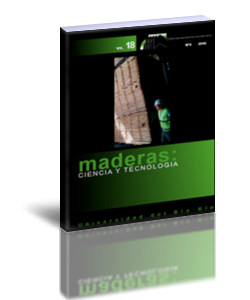Shape and cell wall slenderness effects on the stiffness of wood cell aggregates in the transverse plane
Keywords:
Cell wall shape, computational homogenization, effective stiffness, finite element method, mechanical properties, wood.Abstract
The present study investigates a homogenization method in the framework of finite element method to determine the effective stiffness properties of wood cell aggregates in the transverse plane. For this purpose, square and regular hexagonal representative volume elements are chosen to mimic the wood cells. Thereafter, simulation experiments are conducted to understand how different cell shapes and cell wall slenderness, which is cell wall thickness to height ratio, affect the stiffness properties in the transverse plane. The comparison between analytical and computational homogenization results show that square cells have higher elastic moduli than the ones computed for hexagonal cells whereas shear modulus of both cell shapes have more or less the similar values. This can be explained due to the effective deformation mechanisms under different loading conditions. Thus, the present study provides an effective stiffness estimation tool and insight for wood cell aggregates.Downloads
References
Alkhader, M.; Vural, M. 2008. Mechanical response of cellular solids: Role of cellular topology and microstructural irregularity. Int J Eng Sci 46:1035-1051.
Astley, R.J.; Stol, K.A.; Harrington, J.J. 1998. Modelling the elastic properties of softwood. Holz als Roh- und Werkstoff 56:43-50.
Baar, J.; Tippner, J.; Rademacher, P. 2015. Prediction of mechanical properties - modulus of rupture and modulus of elasticity - of five tropical species by nondestructive methods. Maderas-Cienc Tecnol 17: 239-252.
Charalambakis, N. 2010. Homogenization techniques and micromechanics. A survey and perspectives. Applied Mechanics Review 63:030803-1-10.
Chauhan, S.; Sethy, A. 2016. Differences in dynamic modulus of elasticity determined by three vibration methods and their relationship with static modulus of elasticity. Maderas-Cienc Tecnol 18:373-382.
Deshpande, V.S.; Ashby, M.F.; Fleck, N.A. 2001. Foam topology: bending versus stretching dominated architectures. Acta Materialia 49:1035-1040.
Freund, J.; Karakoç, A.; Sjölund, J. 2014. Computational homogenization of regular cellular material according to classical elasticity. Mech Mater 78:56-65.
Geers, M.G.D.; Kouznetsova, V.G.; Brekelmans, W.A.M. 2010. Multi-scale computational homogenization: Trends and challenges. J Comput Appl Math 234:2175-2182.
Gibson, L.; Ashby, M. 1999. Cellular Solids: Structure and Properties. Cambridge University Press, Cambridge.
Hofstetter, K.; Eitelberger, J.; Bader, T.K.; Hellmich, Ch.; Eberhardsteiner, J. 2009. Computational Multiscale Approach to the Mechanical Behavior and Transport Behavior of Wood. Computational Structural Engineering: Proceedings of the International Symposium on Computational Structural Engineering: 79-85.
Kahle, E.; Woodhouse, J. 1994. The influence of cell geometry on elasticity of softwood. Journal of Materials Science 29:1250-1259.
Karakoç, A. 2013. Effective stiffness and strength properties of cellular materials in the transverse plane. Doctoral thesis, Aalto University, Espoo, Finland.
Karakoç, A.; Freund, J. 2013. A direct simulation method for the effective in-plane stiffness of cellular materials. International Journal of Applied Mechanics 5(3). Number of article: 1350034.
Karakoç, A.; Santaoja, K.; Freund, J. 2013. Simulation experiments on the effective in-plane compliance of the honeycomb materials. Composite Structures 96:312-320.
Laghdir, A.; Fortin, Y.; De la Cruz, C.M.; Hernandez, R.E. 2008. Development of a technique to determine the 3D elasticity tensor of wood as applied to drying stress modeling. Maderas-Cienc Tecnol 10(1):35-44.
Nemat-Nasser, S.; Hori, M. 1999. Micromechanics: Overall Properties of Heterogeneous Materials. North Holland, Amsterdam.
Nguyen, V.; Béchet, E.; Geuzaine, C.; Noels, L. 2012. Imposing periodic boundary condition on arbitrary meshes by polynomial interpolation. Computational Materials Science 55:390-406.
Pham, K.; Kouznetsova, V.G.; Geers, M.G.D. 2013. Transient computational homogenization for heterogeneous materials under dynamic excitation. J Mech Phys Solids 61:2125-2146.
Rafsanjani, A. 2013. Multiscale poroelastic model: bridging the gap from cellular to macroscopic scale. ETH Zurich, Zurich, Switzerland.
Saavedra-Flores, E.I.; Murugan, M.S.; Friswell, M.I.; de Souza-Neto, E.A. 2011. Computational multi-scale constitutive model for wood cell wall and its application to the design of bio-inspired composites. Proc. SPIE 7975, Bioinspiration, Biomimetics, and Bioreplication 7975.
Sjölund, J.; Karakoç, A.; Freund, J. 2014. Accuracy of regular wood cell structure model. Mech Mater 76:35-44.
Wang, A.J.; Kumar, R.S.; McDowell, D.L. 2005. Mechanical Behavior of Extruded Prismatic Cellular Metals. Mechanics of Advanced Materials and Structures 12:185-200.
































